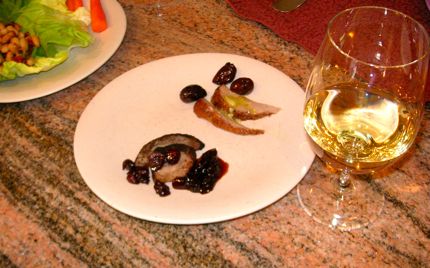Duck Breasts with Lemon-Roasted Olives
October 1, 2009
Duck Breasts with Lemon-Roasted Olives
Varietal: Merlot, Chardonnay, Riesling, Semillon
Serves 4
Slow roasting food on wooden planks made of cedar, alder, or maple gives fish, meat, poultry, and vegetables a distinctive smoky succulence and appealing fresh flavor. Much like the oak barrels in which wine is aged, planks can impart different flavors to food. Western alder is pale yellow to reddish-brown in color with a fine, close grain. Because of its rich, pure smoke flavor (with a light vanilla compliment), western alder is many people’s preferred wood for smoking, as well as the wood traditionally used for smoking food in the Northwest. A wide range of wines works with the duck recipe that follows, thanks to its smoky and salty flavors and rich textures. Try Semillon, Riesling, or Chardonnay among white varietals; Merlot among red wines.
Four 4-ounce boneless, skinless duck breasts
Kosher salt
Freshly ground black pepper
1/3 cup freshly squeezed lemon juice
1 tablespoon minced garlic
1 teaspoon freshly grated lemon zest
1/4 teaspoon lemon pepper
1/3 cup olive oil
20 kalamata or green olives with pits, or a combination
1. At least 15 minutes before cooking, arrange the oven rack in the upper or middle position. Place the plank on the rack, then preheat the oven to 350°F.
2. Sprinkle the duck breasts with salt and pepper. Leaving the heated plank on the oven rack, pull out both the plank and rack and arrange the seasoned breasts on the heated plank without crowding. (This eliminates having to move a hot plank around the kitchen.) Roast for 20 minutes.
3. While the duck is cooking, prepare the dressing by mixing together the lemon juice, garlic, lemon zest, and lemon pepper in a small bowl. Whisk in the olive oil a few drops at a time, incorporating well after each addition, until the sauce is thick and smooth (emulsified).
4. Turn the duck breasts over and surround with the olives; drizzle half the dressing over the duck. Roast for 20 minutes, or until the duck is no longer pink when cut into and the juices run clear (for medium).
5. To serve, divide the duck breasts and olives among 4 dinner plates and drizzle with the remaining dressing.
Cook’s Hint: Before using a wood plank for the first time, it is necessary to “season” it-after multiple seasonings, the plank will turn a rich brown color and will no longer need to be seasoned before each use. To season the plank, pour 1 to 2 tablespoons of olive oil (preferred) or vegetable oil into a small bowl. Using a paper towel or soft, clean cloth dipped in the oil, lightly coat the top surface of the plank with the oil. Do not oil the underside of the plank. Always preheat the plank for 15 minutes, following recipe directions, before placing food on the plank to roast. Also, when your plank is new, and as it develops cracks and warps over time, tighten the steel tightening rods that are inserted along the ends of the plank by using the adjustment tool (supplied with most planks) or a 7/16-inch socket wrench. When planking, do not raise the oven heat about 400°F. Clean the plank with a soft brush, warm water, and mild soap or detergent, never in the dishwasher. And never use a plank designed for use in the oven on a barbecue or grill!
Recipe reprinted from Pacific Northwest Wining & Dining: The People, Places, Food, and Drink of Washington, Oregon, Idaho, and British Columbia (Wiley, 2007, $34.95) by Braiden Rex-Johnson.




No Comments »
No comments yet.
RSS feed for comments on this post. TrackBack URL
Leave a comment